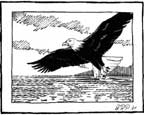|
 Earth Journal Earth Journal
by Gary Pendleton |
 Bald Eagles Soar over Our Tidewater Bald Eagles Soar over Our Tidewater
On a Calvert County back road in 1982, I was thrilled to see a pair of endangered bald eagles up close. I had never seen an eagle before, and I didn’t own a bird book or a pair of binoculars. I had never been birding, but the large white-headed birds were instantly recognizable. That was 22 years, four binoculars and three bird books ago.
Eagle sightings are so common they are no longer remarkable to seasoned birders. On the other hand, most folks who have a pulse are still excited by the sight of an eagle in action.
Eagles were an endangered species in 1982, even though their numbers were on the rise and have increased steadily since. The pesticide DDT was linked to the near demise of eagles, osprey and brown pelicans. DDT was banned in the 1960s, and all these birds have since made significant comebacks.
Today you need go no farther than our tidewater to experience the awe and wonder these great predators inspire.
In eastern and even central Maryland, along the Bay and its tributaries, we have as many bald eagles as we did in the 1930s: more than 300 breeding pairs, a threefold increase since 1990. Around the tidal marshes of the Patuxent River, near Jug Bay, eagles are seen almost daily. In other parts of the state they are even more common.
The bald eagles’ rise from the brink of extinction is one of the great success stories in wildlife conservation. Eagles are still a protected species, though they are no longer on the federal list of endangered species.
|


 Earth Journal
Earth Journal Bald Eagles Soar over Our Tidewater
Bald Eagles Soar over Our Tidewater